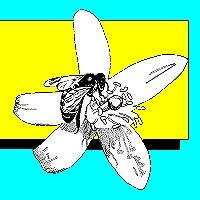APIS Volume 6, Number 10, October 1988

In this issue
- Checking for Pollen in the Fall
- Honey Marketing: Exporting Reports
CHECK FOR POLLEN NOW
The above statement is made in the July-August newsletter From the U.C. Apiaries, written by Dr. Eric Mussen. It is particularly relevant given the situation in northern Florida over the past two seasons. I am printing it in almost its entirety. In almost every instance the word California can be replaced with Florida.
"Most California beekeepers either experienced or heard about calamitous overwintering problems faced by a significant number of our beekeepers a half year ago. Right now we are in that period of time when nature, or the beekeeper, must provide for the needs of the colonies or we will have a repeat performance this coming winter.Of greatest concern is the availability of pollens or suitable substitutes -- not only to provide nutrition for fall brood rearing resulting in young, vigorous wintering bees, but also to feed and keep the queen and bees healthy all winter. I have mentioned before, and it bears repeating, that bees need and consume pollen all winter. Beekeepers from midwestern states have expressed surprise over how fast the large amounts of pollen in their hives disappear when the bees are wintered in the California foothills.
Check your colonies for pollen and brood, NOW. If the queen is laying well, worker brood is abundant and some drones are being raised, then the current protein supply is good. How much pollen is being brought in? How much pollen is stored? You have to check to know.
If egg production is low, worker brood meager, and drone brood nonexistent, then the nutrient conditions in the hive are bad and something must be done. Feeding sugar syrup, alone, will stimulate a little burst of brood rearing. However, the brood will be reared at the expense of the worker bees, since pollen is not available to supply the required nutrients. Therefore, the nutrients will be extracted from the organs of the worker bees by a process similar to self digestion. This condition can be tolerated for one or two "rounds of brood" but will lead to disaster if it continues until next spring.
If pollen is short, can pollen substitutes replace them? 'Yes' and 'No.' To my knowledge, no one has developed a substitute bee feed that comes close to stimulating and supporting brood rearing in the manner that a good mix of pollens does. However, many pollen substitutes have been documented to increase brood rearing in feeding trials. The nutrients provided by substitutes are adequate to prevent the nurse bees from exhausting their body reserves in their efforts to produce brood. Immature bees are fed adequately and the workers remain healthy enough to survive the winter. Substitute-fed bees will not build up large fall populations, as do colonies within flight range of good pollen sources. Instead, the smaller populations show reduced winter mortality and respond with vigor when the first pollens become available in the spring.
What nutrients must bees obtain from their solid food? Basically, proteins, fats, vitamins, and minerals. Their amino acids requirements mimic other animals - 10 essential ones must be eaten. Fatty acids and cholesterol precursors are required, too. The B vitamin complex (water soluble vitamins) are required, but experiments with vitamins A and D (fat soluble) produced no benefits when they are added to basic diets. Various minerals are required, but any substitute feed we offer appears to have plenty of 'ash.'
Is there a reasonably priced, fairly easy to handle substance that provides most of these needed nutrients? Yes--various types of dried yeasts. The most commonly fed yeast is brewer's yeast, a by-product of commercial fermentation. The original Torula yeast was grown on wood pulp and the original Wheast was grown on whey. More recently, feed yeasts have been grown on corn and other substrates. The feed yeasts are more expensive than brewer's yeast and provide somewhat better nutrition.
In all these products, the yeast cells are collected and dried, then packaged for feeding to animals. The only potential problem with these yeasts is the possibility of too high a salt content. Yeasts that are centrifuged or strained from solution before drying should be useful. If the total solution is simply dried down and the yeast is then powdered, all the salts in the solution will be included with the yeast cells. Check the specifications of salt content and keep it below 2%.
What is the best way to feed yeast to bees? Opinions vary. Bees will collect dry yeast from a box left out in the bee yard. Some yeast is carried to the hive and placed in the comb cells, but there is little indication that any is eaten. Placed inside the hive, dry yeast is frequently carried out by the bees.
Yeast formulated as moist patties seems to be accepted better by the bees. Success seems to be better when syrups made of partially inverted sugars are used in the patties. The fructose attracts and holds moisture, so the patties do not become hard. Diluted honey will have the same properties, but it is teeming with microorganisms that will cause the patty to spoil if the bees do not devour it quickly. Adding a little (5-10%) pollen to the 'substitute' (now called 'supplement') will induce better feeding and may provide some extra nutritional value.
Observations made by California beekeepers suggest that yeast feeds should be used when some pollen is still being collected. When pollen is no longer available, interest in consuming pollen substitute appears to become nonexistent. This is an excellent reason to inspect your hives soon and if protein feeding is necessary, START RIGHT NOW! And once you start feeding, do not stop until either the bees lose interest or you no longer wish to rear brood. A one-shot feeding probably will not provide the results that you hope to obtain. Stick with it for a month or more. Also, providing sugar syrup at this time appears to enhance the benefits of feeding protein.
The costs involved in purchasing the food items, preparing them, and putting them on the hives are significant. If you manage to save an otherwise lost colony, probably the investment was worthwhile. However, we are really trying to provide the best bees possible in the spring to benefit the almond growers. Therefore, it would seem reasonable to split the cost of feeding with the consumer who should benefit significantly from your stronger bee populations."
MORE ON EXPORTING HONEY
[Editor's note: See also July 1988 APIS]
The Foreign Agricultural Service (FAS) of the USDA has approved the National Honey Board's request for $500,000 in Targeted Export Assistance (TEA) funds for 1989. They are provided to offset adverse effects of unfair foreign trade practices on U.S. agricultural exports.
Primary efforts will be in West Germany, Saudi Arabia and Japan. An export development program will be launched October 1. The National Honey Board will first do some market research then develop multi-lingual promotional materials, participate in international trade shows and sponsor export sales seminars. The goal is to increase U.S. honey export sales from 3 to 15 percent of U.S. production. Markets for premium U.S. products will be developed in selected countries. For more information, contact the National Honey Board directly, 9595 Nelson Rd., Box C, Longmont, CO 80501, ph 303/776- 2337.
A report has been released by Mike Whitehead, International Marketing Supervisor, Florida Department of Agriculture and Consumer Services. The purpose of the report is to present information on the world honey market recently gathered by the Department to the Florida beekeeping industry.
Of special importance to Florida honey exporting is the European community, according to Mr. Whitehead. The largest customer is West Germany. Unfortunately, Florida's share of this market declined to 19.3% in 1987, down from 43.5% in 1986. However, the U.S. is only filling a fraction of the total German demand for honey. There now exists an excellent opportunity to increase sales as the dollar declines in value. One part of this strategy will be to attend the largest food show in the world, ANUGA, October 1989, in Cologne, West Germany. Mr. Whitehead will assist those exporters interested in attending.
According to the report, the majority of Florida honey exports are now conducted by two firms. Their success is attributed to:
- Traveling to overseas markets to renew contacts and establish new ones.
- Staying in the international business for the long term, not just temporarily.
- Securing reliable overseas communication, such as FAX or TELEX.
- Making an extra effort to take care of foreign customers.
The report also says that the latest evidence is promising. Unofficial export statistics through May 1988 show Florida to be the leading exporter in the U.S., with increasing sales to non-European regions like Asia. A copy of the report can be requested from Mr. Whitehead, , 414 Mayo Bldg., Tallahassee, FL 32399-0800.
Sincerely,
Malcolm T. Sanford
Bldg 970, Box 110620
University of Florida
Gainesville, FL 32611-0620
Phone (352) 392-1801, Ext. 143 FAX: (352)-392-0190
http://www.ifas.ufl.edu/~mts/apishtm/apis.htm
INTERNET Address: MTS@GNV.IFAS.UFL.EDU
©1988 M.T. Sanford "All Rights Reserved

















